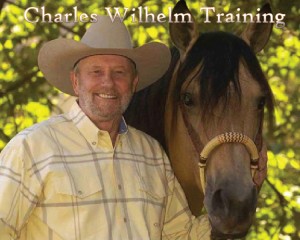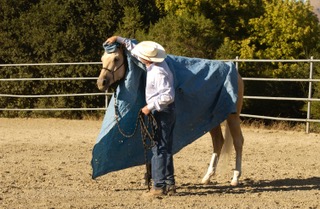-By Charles Wilhelm-
Horses are prey animals, they are programmed to fight or flee. It is part
of the herd instinct. If something startles a horse or it sees something out
of the ordinary, the response is to escape. The head goes up and the feet
start to move. Some horses have a higher emotional level than others.
On a scale of one to ten, one being unresponsive and ten being
extremely sensitive, we want to aim for a good balance. We want the
horse to respond but not to freak out. If a horse is too unresponsive or
cold as we say, it is not going to listen when I put a leg on it. If the horse
is a ten, it is not going to listen because it is too distracted and edgy. The
horse doesn’t care what my leg is doing because it is so nervous.

Sacking out is a way of making a horse safe. The birdie is one tool that I use to desensitize or sack out a horse. I use a variety of tools to bring down the emotional level and get a horse comfortable with strange objects, as well as things bumping and dragging around the feet.
I determine the level of flight instinct for each horse and I work from that point. I like to use a 2 to 14-foot line and a rope halter. I begin  by teaching the horse to lunge. To move around me, stop the feet, pause and change direction. I do this at the walk, trot, and lope gaits. If the horse has not been worked in several days, this exercise takes the freshness off the horse and gets the horse to focus on the work we are doing. When we teach a horse to go forward, stop, pause and change direction we are controlling the feet. When we have control of the feet, we begin to get the horse’s attention. This happens more quickly with some horses. With a horse that has more flight instinct or a higher emotional level in general, it takes long for the horse to relax and to see a quietness in the gaits.
by teaching the horse to lunge. To move around me, stop the feet, pause and change direction. I do this at the walk, trot, and lope gaits. If the horse has not been worked in several days, this exercise takes the freshness off the horse and gets the horse to focus on the work we are doing. When we teach a horse to go forward, stop, pause and change direction we are controlling the feet. When we have control of the feet, we begin to get the horse’s attention. This happens more quickly with some horses. With a horse that has more flight instinct or a higher emotional level in general, it takes long for the horse to relax and to see a quietness in the gaits.
 I used to sack out horses using my hands but some horses kick out and it is safer to use a stick. I use an inexpensive 42-inch-long dressage stick. I remove the lash which leaves a small loop on the end. I hold the lead rope in my left hand at the snap. I want the nose slightly bent in as I work on the left side of the horse. With my right hand, I bring the stick toward the horse and then take it away without touching the horse. When the horse is okay with this, I bring the end closer until I can touch the horse. This is what I call pressure and release. We always want to release the pressure before the horse gets too excited. You must find where you need to start with your horse. The goal is to touch the horse all over: feet, legs, belly, head, ears, and back. This exercise makes a horse safe for you and a farrier to handle. Also, I have seen small children run up and grab a horse by the leg. It is a huge benefit to have a quiet, calm horse that does not respond to this type of situation by kicking or jumping.
I used to sack out horses using my hands but some horses kick out and it is safer to use a stick. I use an inexpensive 42-inch-long dressage stick. I remove the lash which leaves a small loop on the end. I hold the lead rope in my left hand at the snap. I want the nose slightly bent in as I work on the left side of the horse. With my right hand, I bring the stick toward the horse and then take it away without touching the horse. When the horse is okay with this, I bring the end closer until I can touch the horse. This is what I call pressure and release. We always want to release the pressure before the horse gets too excited. You must find where you need to start with your horse. The goal is to touch the horse all over: feet, legs, belly, head, ears, and back. This exercise makes a horse safe for you and a farrier to handle. Also, I have seen small children run up and grab a horse by the leg. It is a huge benefit to have a quiet, calm horse that does not respond to this type of situation by kicking or jumping.
Once I have worked both sides of a horse with the dressage stick, I get the birdie. The birdie is a small plastic bag, like a produce bag, or piece of crinkly plastic. I thread the bag or plastic through the small loop at the end of the dressage stick. If the horse I am working is nervous, I tie the bag or plastic in a ball so that it is less threatening. I repeat the same exercise,  starting out further with the pressure/release, until I can touch the horse all over with the plastic. As the horse becomes more comfortable, I untie the plastic until the bag or sheet is full size. The next step is to shake the plastic over the top of the horse. Again, because horse are prey animals, they often do not like things above them. The birdie is a great tool. I teach the horses that the birdie is their friend. I do not want them to be afraid of it. I just want them to accept different types of pressure. I also use the ball and the tarp because each one represents something out of the ordinary. The birdie is an inexpensive tool that is easy to use and the exercise is appropriate for and adaptable to every horse.
starting out further with the pressure/release, until I can touch the horse all over with the plastic. As the horse becomes more comfortable, I untie the plastic until the bag or sheet is full size. The next step is to shake the plastic over the top of the horse. Again, because horse are prey animals, they often do not like things above them. The birdie is a great tool. I teach the horses that the birdie is their friend. I do not want them to be afraid of it. I just want them to accept different types of pressure. I also use the ball and the tarp because each one represents something out of the ordinary. The birdie is an inexpensive tool that is easy to use and the exercise is appropriate for and adaptable to every horse.
 national clinics and demonstrations.
national clinics and demonstrations. 





















































